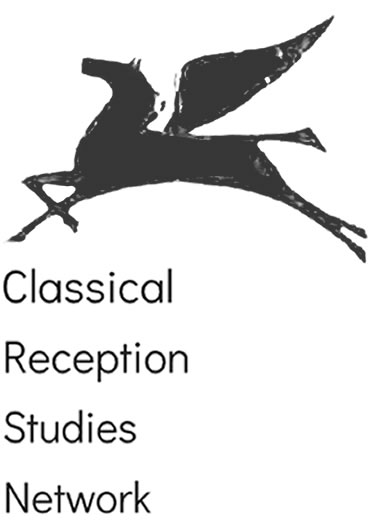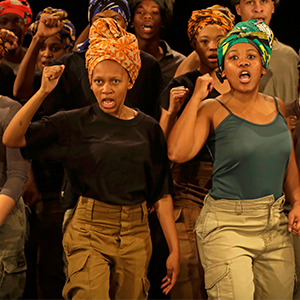This thirteenth blog of the African takeover is written by Dr Lekan Balogun, post-doctoral fellow at the University of Cape Town. His PhD from the Victoria University of Wellington, New Zealand followed his BA and MA degrees in Theatre Arts, at the University of Lagos, Akoka, Nigeria. Dr Balogun is currently participating in the ReTAGS project.
Symbolism, Edan Ògbóni and the Spectacular in Mark Fleishman’s Antigone (not quite/quiet)
By Lekan Balogun

When I arrived in Cape Town, South Africa, sometime in August 2019, to take up a place as a Postdoctoral Fellow on the Andrew W. Mellon-funded project “Reimagining Tragedy from Africa and the Global South” (ReTAGS) at the Centre for Theatre, Dance and Performance Studies (CTDPS) of the University of Cape Town (UCT), little did I know that I was going to be a part of some strange history. Sure, the project that took me to South Africa was quite different from what took me to Wellington, New Zealand, where I spent four years. Nonetheless, I looked forward to the project with excitement, carrying around a copy of Babatunde Lawal’s fantastic essay, “À Yà Gbó, À Yà Tó: New Perspectives on Edan Ògbóni” which became invaluable for my reading through the lens of a Yoruba ritual aesthetics of Mark Fleishman’s spectacular production, Antigone (not quite/quiet), the first in a series of productions for the ReTAGS project. However, few weeks after my arrival, I was reminded of my childhood by some disturbing events particularly the brutal rape and murder of a first-year-student of UCT and the outbreak of another round of xenophobic attacks of foreign nationals by scores of angry, belligerent Black South Africans. I tried endlessly to make sense of the two violent acts while attending rehearsal of Fleishman’s production. During those times memories of my childhood kept returning into my head as the production built up to its premiere.
Symbols of servitude and incarceration, of people in chains, and the images of iconic personalities such as Nelson Mandela, Oliver Tambo, and Desmond Tutu etc., defined my childhood perception of South Africa. Inspired also by literature such as Alan Paton’s Cry, the Beloved Country, Alex La Guma’s A Walk in the Night and Other Stories and Percy Mtwa, Mbongeni Ngema and Barney Simon’s Woza Albert!; and the music of Miriam Makeba and Nigeria’s Sonny Okosun, all I saw was the evil of apartheid and the cruelty of the White minority towards the majority Black population who had before them an enormous task of emancipation. Mandela’s release from prison and his subsequent victory at the 1994 polls changed that perception and, like the rest of the world, I celebrated the collapse of apartheid as the victory of human will against oppression.
But this soon turned out to be a flash in the pan. I was filled with resentment and anger towards the same Black people of South Africa for their demonstrated hatred for their fellow Africans and those who identified with their struggle for emancipation. Xenophobia was totally unacceptable, the Marikana massacre was nothing but hideous, and the sense in both eluded me. In all, I saw the collapse of apartheid as a movement from “the credo of being into nothingness” to rephrase Soyinka. At the end, the ghost of the initial symbolism of terror that haunted my childhood returned with renewed vigour. And, things fell apart!
But I changed my mind in September 2019 when Antigone (not quite/quiet) premiered at The Baxter, on the campus of the University. It was a spectacular show, a three-part response, or triptych, to the Classical tale of Antigone. It was described by some members of the audience who saw it as a “highly-charged and theatrically-enthralling piece” (Cheryl Hewson); “[a] tour de force…an intellectual workout…muscular theatre which challenges and stimulates its audience” (Beverly Brommert); and “[a] masterful statement that interrogates our relationship to tradition, especially that which is not ours, and forges a collaborative interpretation of a single story”(Faye Kabali-Kagwa). The production was Fleishman’s third “response” to Greek tragedy, the other two being Medea (1994) and In the City of Paradise (1998). It is a “third” in which the figure “three” represents the complexity of the relation among servitude, activism and freedom. It is also one that offers itself as the intersection of aesthetics and ritual imagination.
While Fleishman’s production shows how the past is useful to address the failures of the present, I wonder how the ritual and aesthetic connotations of the play’s dramatic structure and characterization can be explained by drawing from what Lawal articulates about the symbolism of the Edan Ògbóni in “À Yà Gbó, À Yà Tó.” In this short piece, I use that symbolism to reflect on the aesthetic and political content of the production. As a symbol of law and order, and the embodiment of the spirit of peace for human survival, happiness, fortitude and social stability, the Edan becomes useful to elaborate on the production’s theme of social revitalization and communal regeneration, to comment on theatre’s relationship with ritual, and to discuss some of the ways in which the Edan’s relationship to the Earth and its physical and spiritual connotations are useful for exploring the “spectacular” in Antigone (not quite/quiet) in the context of the revolutionary potentials of ritual (imagination) and symbolic representation of the (un)real.
Fleishman’s aesthetic choice shows his preference for highly imaginative and intellectually-stimulating theatrical production as well as a deep concern with tragedy, both as an idea—an inherited concept—and an artistic form, in its various manifestations. “Tragedy,” for Raymond Williams, “is not a single and permanent kind of fact,” nor is it for Fleishman, but “a series of experiences and conventions and institutions.” It involves an “overlap of issues” that “rang[e] from sexual conflict, adultery, gender inequality” according to Rita Felski. Moreover, for Fleishman, tragedy also has to do with the impact of change and modernity, progress and its opposites, or what he sums up as the “aftermaths” (post-apartheid South Africa from the period after Mandela’s victory of 1994), such as violence and xenophobia that are the direct consequences of political failure and economic malfeasance, sexual and gender-based violence of unimaginable proportions due to the slow but persistent breakdown of congenial social relations etc. It is tragedy that is lived and experienced daily. In short, for Fleishman, the tragedy following the collapse of apartheid is that of a nation in perpetual transition, while he presents this social atrophy and uses the resources of culture to reaffirm the notion of culture as “lived history.” Continued on blog 14

